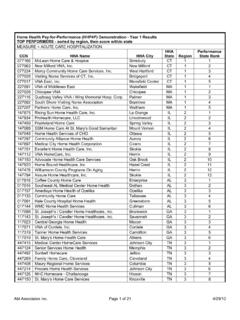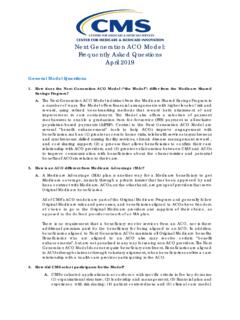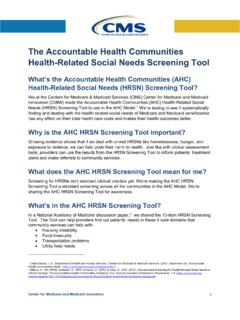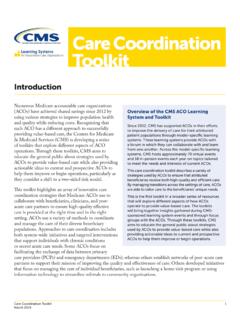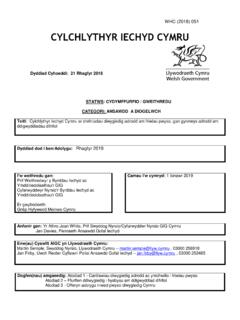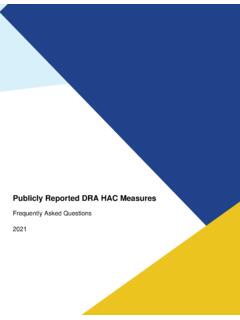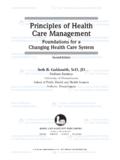Transcription of Quality Measures Fact Sheet - Centers for Medicare ...
1 Quality Measures Fact Sheet CMS Patient Safety Indicators PSI 90 (NQF #0531) National Quality Strategy Domain: Patient Safety BPCI Advanced and Quality The Center for Medicare & Medicaid Innovation s (the CMS Innovation Center s) BPCI Advanced Model rewards health care providers for delivering services more efficiently, supports enhanced care coordination, and recognizes high Quality care. Hospitals and clinicians should work collaboratively to achieve these goals, which have the potential to improve the BPCI Advanced Beneficiary experience and align to the CMS Quality Strategy goals of promoting effective communication and care coordination, highlighting best practices, and making care safer and more affordable.
2 A goal of the BPCI Advanced Model is to promote seamless, patient-centered care throughout each Clinical Episode, regardless of who is responsible for a specific element of that care. Background on CMS Patient Safety Indicators 90 Following the seminal To Err is Human report from the Institute of Medicine, the Agency for Healthcare Research and Quality (AHRQ) developed Measures that health providers can use to identify potential in- hospital patient safety problems for targeted institution-level Quality improvement efforts. These Patient Safety Indicators (PSIs) are comprised of 26 Measures (including 18 provider-level indicators) that highlight safety-related adverse events occurring in hospitals following operations, procedures, and childbirth.
3 CMS developed the PSIs after a comprehensive literature review, analysis of available International Classification of Diseases (ICD) codes, review by clinical panels, implementation of risk adjustment, and empirical analyses. CMS Innovation Center Rationale for Including the CMS PSI 90 Measure in BPCI Advanced The CMS Patient Safety and Adverse Events Composite (CMS PSI 90) is a subset of the AHRQ Patient Safety Indicators and is a more relevant measure for the Medicare population because it utilizes ICD-10 data. The CMS PSI 90 measure summarizes patient safety across multiple indicators, monitors performance over time, and facilitates comparative reporting and Quality improvement at the hospital level.
4 The CMS PSI 90 composite measure (updated on August 23, 2018) intends to reflect the safety climate of a hospital by providing a marker of patient safety during the delivery of care. The CMS Innovation Center is promoting this measure for BPCI Advanced because it may inform how patients select care options, providers allocate resources, and payers evaluate performance. CMS uses the CMS PSI 90 software to produce the CMS PSI 90 results. CMS has used or is currently using the CMS PSI September 2019 1 90 measure in the following Federal programs: the hospital Inpatient Quality Reporting Program, Value-Based Purchasing Program, and hospital - acquired Condition Reduction Program.
5 Applicable Clinical Episodes The CMS PSI 90 measure is in the Administrative Quality Measures Set and applies to the following inpatient Clinical Episodes included in the BPCI Advanced Model: Acute Myocardial Infarction: Medicare Severity-Diagnosis-Related Groups (MS-DRGs) 280, 281, and 282 Back and Neck Except Spinal Fusion: MS-DRGs 518, 519, and 520 Bariatric Surgery: MS-DRGs 619, 620, and 621 Cardiac arrhythmia: MS-DRGs 308, 309, and 310 Cardiac Defibrillator: MS-DRGs 222, 223, 224, 225, 226, and 227 Cardiac Valve: MS-DRGs 216, 217, 218, 219, 220, and 221 Cellulitis: MS-DRGs 602 and 603 Congestive Heart Failure: MS-DRGs 291, 292, and 293 COPD, bronchitis, asthma: MS-DRGs 190, 191, 192, 202, and 203 Coronary Artery Bypass Graft: MS-DRGs 231, 232, 233, 234, 235, and 236 Disorders of the liver excluding malignancy, cirrhosis, alcoholic hepatitis: MS-DRGs 441, 442, and 443 Double Joint Replacement of the Lower Extremity: MS-DRGs 461 and 462 Fractures of the Femur and Hip or Pelvis.
6 MS-DRGs 533, 534, 535, and 536 Gastrointestinal hemorrhage: MS-DRGs 377, 378, and 379 Gastrointestinal obstruction: MS-DRGs 388, 389, and 390 Hip and Femur Procedures Except Major Joint: MS-DRGs 480, 481, and 482 Inflammatory Bowel Disease: MS-DRGs 385, 386, and 387 Lower Extremity and Humerus Procedure Except Hip, Foot, Femur: MS-DRGs 492, 493, and 494 Major Bowel Procedure: MS-DRGs 329, 330, and 331 Major Joint Replacement of the Lower Extremity: MS-DRGs 469 and 470; Healthcare Common Procedure Coding System (HCPCS) 27447 Major Joint Replacement of the Upper Extremity: MS-DRG 483 Pacemaker: MS-DRGs 242, 243, and 244 Percutaneous Coronary Intervention: MS-DRGs 246, 247, 248, 249, 250, and 251 Renal failure: MS-DRGs 682, 683, and 684 Seizures: MS-DRGs 100 and 101 Sepsis: MS-DRGs 870, 871, and 872 Simple pneumonia and respiratory infections: MS-DRGs 177, 178, 179, 193, 194, and 195 Spinal Fusion: MS-DRGs 453, 454, 455, 459, 460, 471, 472, and 473 Stroke.
7 MS-DRGs 61, 62, 63, 64, 65, and 66 Transcatheter Aortic Valve Replacement: MS-DRGs 266 and 267 Urinary Tract Infection: MS-DRGs 689 and 690 September 2019 2 Measure Specifications The CMS PSI 90 measure selected for BPCI Advanced follows National Quality Forum (NQF) #0531 measure specifications. CMS calculates the measure at the hospital level and calculates a weighted average based on each of the following indicators: PSI 03 pressure ulcer Rate PSI 06 Iatrogenic Pneumothorax Rate PSI 08 In- hospital Fall with Hip Fracture Rate PSI 09 Perioperative Hemorrhage or Hematoma Rate PSI 10 Post-Operative Acute Kidney Injury Requiring Dialysis Rate PSI 11 Postoperative Respiratory Failure Rate PSI 12 Perioperative Pulmonary Embolism or Deep Vein Thrombosis Rate PSI 13 Postoperative Sepsis Rate PSI 14 Postoperative Wound Dehiscence Rate PSI 15 Unrecognized Accidental Puncture or Laceration Rate For Acute Care Hospitals (ACHs)
8 Participating in BPCI Advanced, the CMS Innovation Center will calculate performance at the hospital level for all Medicare beneficiaries included in the denominator. For Physician Group Practices (PGPs), the CMS Innovation Center will calculate the measure as specified at the hospital level, then weight the measure based on PGP Clinical Episode volume for each ACH where a PGP triggers an episode. Denominator and Numerator The table below provides high level descriptions of the numerator and denominator for each component of the CMS PSI 90.
9 The CMS PSI 90 measure is not limited to BPCI Advanced Beneficiaries. More detailed measure specifications, as well as inclusion and/or exclusion criteria, are in the links provided in the Other Resources table below, including the CMS Measures Inventory Tool: PSI 90 and the ten PSI measure ICD-10-CM/PCS specification overviews. Measure Numerator Denominator PSI 03: pressure ulcer Rate Qualifying discharges with any secondary ICD-10-CM diagnosis codes for pressure ulcer stage III or IV (or unstageable). Surgical or medical discharges for Medicare Fee-For-Service (FFS) beneficiaries ages 18 years and older.
10 PSI 06: Iatrogenic Pneumothorax Rate Qualifying discharges with any secondary ICD-10-CM diagnosis codes for iatrogenic pneumothorax. Surgical or medical discharges for Medicare FFS beneficiaries ages 18 years and older. PSI 08: In- hospital Fall with Hip Fracture Rate Qualifying discharges with any secondary ICD-10-CM diagnosis codes for hip fracture. Surgical or medical discharges for Medicare FFS beneficiaries ages 18 years and older. September 2019 3 Any secondary ICD-10-PCS procedure codes for a mechanical ventilation for less than 96 consecutive hours (or undetermined) that occurs two or more days after the first major operating room procedure code Measure Numerator Denominator PSI 09: Perioperative Hemorrhage and Hematoma Rate Qualifying discharges wit
